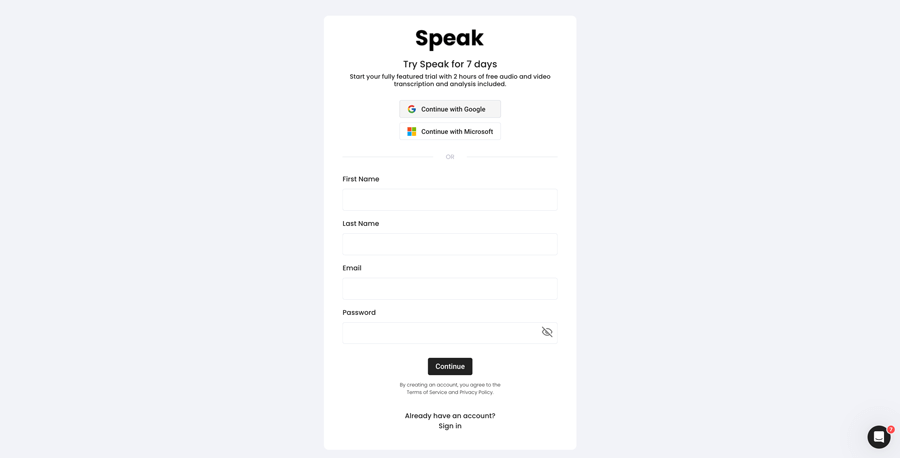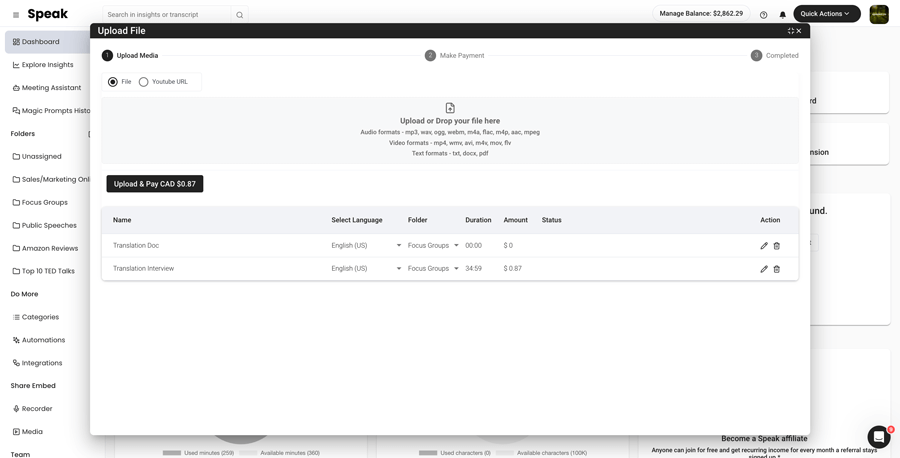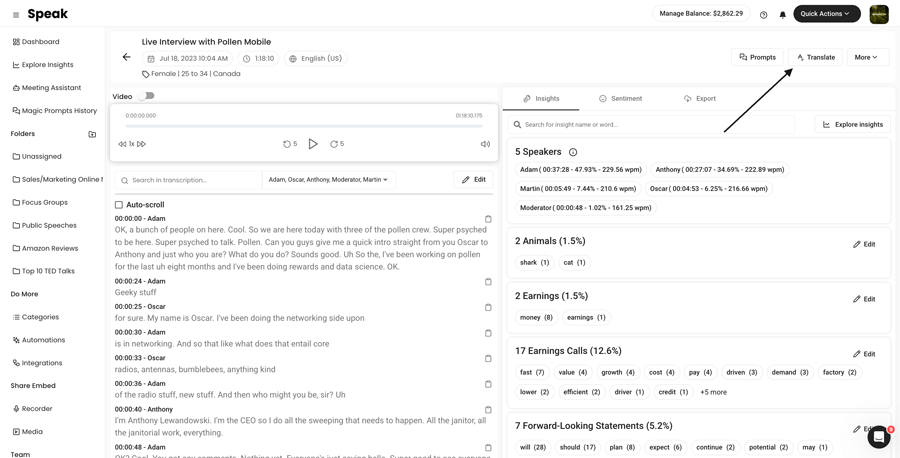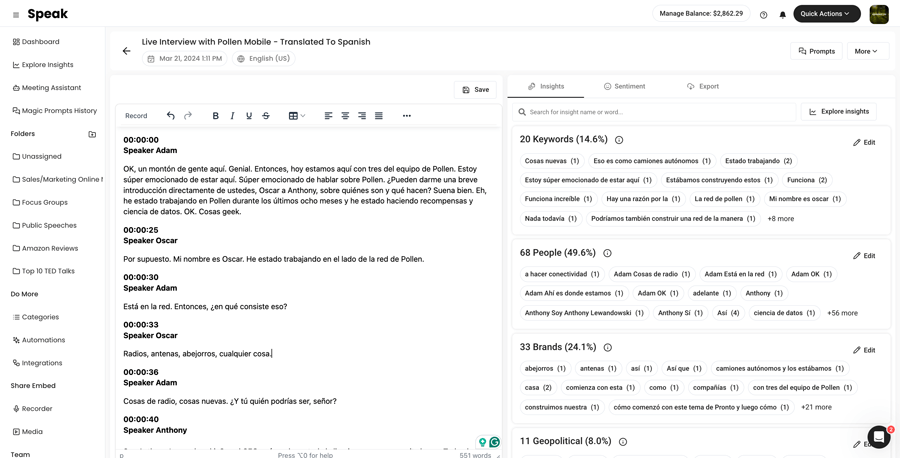How To Translate Japanese to Chinese (Traditional)
Translating Japanese to Chinese (Traditional) is super simple!

Step 1: Register for Speak
Register for Speak using this link.
Once you register, you can instantly begin translating your Japanese to Chinese (Traditional) file(s).

Step 2: Upload Your Japanese file(s)
As soon as you log in, you will be redirected to the dashboard.
Once there, you can select the Quick Action "New Upload".
In Speak, you can seamlessly upload, transcribe and translate audio, video and text files all at once!

Step 3: Translate Your Japanese file(s) to Chinese (Traditional)
Once the file is uploaded, simply visit your file and select "Translate".
If it is an audio and video file, Speak will ask you if you want to keep the speaker names and timestamps in the translation.
Want to translate many files at once? No problem!
You can view the files you want to automatically translate from Japanese to Chinese (Traditional) from the folder level and instantly translate as many files as you need with our artificial intelligence translation in just a few clicks.

Step 4: That's It! View, Analyze, Modify & Export Your New Chinese (Traditional) file(s)
Once the translation is done, you will be alerted and you will see a new document in the same folder your original file is in.
The file will be named the same but with a dash indicating that it is the translated version.
Need support with your Japanese translation?
We are always here and happy to help at Speak!
Just send us a message on live chat on the bottom right corner and we will ensure you are set up for success.
Interested in translating Japanese or other languages to different languages? View our entire list of supported translation languages here.
Automatic, accurate, instant AI translation from Japanese to Chinese (Traditional) is here for you.
Register for Speak using this link and begin translating Japanese to Chinese (Traditional) today.
Unlocking the Power of AI in Language Translation: Japanese to Chinese (Traditional)
In the era of globalization, the ability to communicate transcends geographical boundaries, opening up limitless opportunities for businesses and researchers alike. One of the most significant challenges in this global landscape is the language barrier. Specifically, translating Japanese to Chinese (Traditional) presents unique opportunities for individuals and organizations looking to expand their reach in East Asia. With advancements in Artificial Intelligence (AI), automatic translation has become not just a possibility but a practical tool. Speak AI, a leader in Natural Language Processing and transcription software, is at the forefront of this innovation, offering seamless Japanese to Chinese (Traditional) translation.
The Strategic Importance of Japanese to Chinese (Traditional) Translation
Both Japanese and Chinese (Traditional) are languages of immense significance in the business and academic worlds. Pairing these languages through accurate translation opens doors to vast markets and rich knowledge repositories in East and Southeast Asia. Here's how leveraging AI for this translation can be transformative:
- Business Expansion: Companies aiming to infiltrate the East Asian markets can communicate effectively with local partners and consumers.
- Academic Research: Scholars can access and share valuable research without the constraints of language barriers, enriching global knowledge.
- Cost and Time Efficiency: Automatic translation significantly reduces the cost and time associated with traditional translation methods, facilitating quicker decision-making and action.
Benefits of AI-Powered Translation
Speak AI's translation services offer several advantages:
- Accuracy: Utilizing NLP and large language models, translations maintain the nuance and context of the original text.
- Integration: Speak AI seamlessly integrates with platforms like Microsoft Teams, Zoom, Google Meet, and Webex, offering real-time translation for international meetings.
- Data Visualization: Post-translation, data visualization tools help in analyzing the content, aiding in better understanding and decision-making.
Why Choose Speak AI for Japanese to Chinese (Traditional) Translation?
With a 4.9 rating on G2 and over 150K users, Speak AI's platform is a testament to its effectiveness and reliability. Whether translating audio, video, or text, the platform supports researchers and businesses in their quest for a broader audience and deeper understandings.
Breaking Language Barriers: A Deeper Dive into Japanese and Chinese (Traditional) Cultures
Geographical and Social Context
Japanese and Chinese (Traditional) are primarily spoken in Japan and Taiwan, respectively, with significant communities worldwide. These languages represent cultures steeped in history, contributing to their global resonance and the increasing need for precise translation services.
Fun Facts and Similarities
Despite their distinct origins, Japanese and Chinese (Traditional) share several cultural and linguistic similarities, such as the use of Kanji characters in Japanese which are derived from Chinese characters. Moreover, both cultures celebrate similar festivals, rooted deeply in their shared heritage and history.
The Value of Translation in Cultural Exchange
Understanding and translating these languages is not just about conveying words but also about bridging cultures. Through accurate translation, businesses and researchers can partake in this rich cultural exchange, fostering deeper connections and mutual respect.
Conclusion: The Future is Translated
The future of global interaction lies in breaking down language barriers, and the role of AI in this journey is indisputable. Speak AI's emphasis on accurate, efficient, and integrated Japanese to Chinese (Traditional) translation services exemplifies the potential of technology to bring the world closer. Whether for business expansion, academic research, or cultural understanding, the power to translate is the power to transcend limits.
Embrace the future of communication with Speak AI's translation services and witness the transformation in global interactions firsthand.
FAQs
Q: What locations are Japanese and Chinese (Traditional) popular?
A: Japanese is predominantly spoken in Japan, with a population of about 126 million. Conversely, Chinese (Traditional) is primarily used in Taiwan, Hong Kong, and Macau. Additionally, large diaspora communities around the world speak these languages, underlining their global importance.
Q: What are some fun facts about Japanese and Chinese (Traditional)?
A: One intriguing fact is that both languages utilize a form of characters derived from ancient Chinese script. Moreover, the Japanese calendar system and several cultural practices have origins in Chinese traditions, illustrating a rich historical interconnection.
Q: What are the differences and similarities between Japanese AND Chinese (Traditional)?
A: While the two languages share historical and cultural links, such as the adaptation of Chinese characters into Japanese writing, there are stark differences in grammar, pronunciation, and syntax. However, both languages emphasize respect and hierarchy in their communication, reflecting deeper cultural values.
Translate Japanese To These Other Supported Languages:
- Translate Japanese-to-Arabic (Egypt)
- Translate Japanese-to-Arabic (Iraq)
- Translate Japanese-to-Arabic (Israel)
- Translate Japanese-to-Arabic (Jordan)
- Translate Japanese-to-Arabic (Kuwait)
- Translate Japanese-to-Arabic (Lebanon)
- Translate Japanese-to-Arabic (Oman)
- Translate Japanese-to-Arabic (Palestinian Authority)
- Translate Japanese-to-Arabic (Qatar)
- Translate Japanese-to-Arabic (Saudi Arabia)
- Translate Japanese-to-Arabic (Syrian Arab Republic)
- Translate Japanese-to-Arabic (United Arab Emirates)
- Translate Japanese-to-Arabic Modern Standard (Bahrain)
- Translate Japanese-to-Armenian
- Translate Japanese-to-Bulgarian
- Translate Japanese-to-Catalan
- Translate Japanese-to-Chinese (Cantonese, Traditional)
- Translate Japanese-to-Chinese (Simplified)
- Translate Japanese-to-Chinese (Traditional)
- Translate Japanese-to-Croatian
- Translate Japanese-to-Czech
- Translate Japanese-to-Danish
- Translate Japanese-to-Dutch
- Translate Japanese-to-English
- Translate Japanese-to-English (Australia)
- Translate Japanese-to-English (India)
- Translate Japanese-to-English (Ireland)
- Translate Japanese-to-English (New Zealand)
- Translate Japanese-to-English (Scottish)
- Translate Japanese-to-English (South African)
- Translate Japanese-to-English (United Kingdom)
- Translate Japanese-to-English (United States)
- Translate Japanese-to-Estonian
- Translate Japanese-to-Farsi
- Translate Japanese-to-Finnish
- Translate Japanese-to-French
- Translate Japanese-to-French (Canada)
- Translate Japanese-to-German
- Translate Japanese-to-German (Swiss)
- Translate Japanese-to-Greek
- Translate Japanese-to-Gujarati
- Translate Japanese-to-Hebrew
- Translate Japanese-to-Hindi
- Translate Japanese-to-Hungarian
- Translate Japanese-to-Icelandic
- Translate Japanese-to-Indonesian
- Translate Japanese-to-Irish
- Translate Japanese-to-Italian
- Translate Japanese-to-Japanese
- Translate Japanese-to-Kannada
- Translate Japanese-to-Korean
- Translate Japanese-to-Latvian
- Translate Japanese-to-Lithuanian
- Translate Japanese-to-Malay
- Translate Japanese-to-Malayalam
- Translate Japanese-to-Norwegian
- Translate Japanese-to-Persian
- Translate Japanese-to-Polish
- Translate Japanese-to-Portuguese
- Translate Japanese-to-Portuguese (Brazilian)
- Translate Japanese-to-Portuguese (Portugal)
- Translate Japanese-to-Romanian
- Translate Japanese-to-Russian
- Translate Japanese-to-Slovak
- Translate Japanese-to-Slovenian
- Translate Japanese-to-Spanish
- Translate Japanese-to-Spanish (Mexico)
- Translate Japanese-to-Swedish
- Translate Japanese-to-Tamil
- Translate Japanese-to-Telugu
- Translate Japanese-to-Thai
- Translate Japanese-to-Turkish
- Translate Japanese-to-Ukrainian
- Translate Japanese-to-Vietnamese



